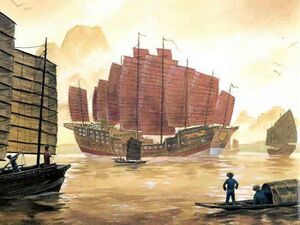South Seas Development Company
 Flag used during the 1800's by the South Seas Trading Company | |
| Company type | Public |
|---|---|
| Industry | International trade |
| Founded | 19 March 1638 |
| Headquarters | , |
Area served | Alshar, Australis, Ocean of Cathay |
The South Seas Development Company, previously known as the South Seas Trading Company is a Daxian joint-stock company originally founded in 1638 to trade in the Ocean of Cathay region. It expanded its interests to Australis, specifically the Daxian colonies in Zhijun and Stenza; being granted enormous economic concessions there from the Qian government in exchange for its development of local industries and use of its manpower to help maintain control of the colonies. The company sought an alternative route to avoid the Burgoignesc island chokepoints known as La Garrote and its extortionate tariffs by developing what came to be known as the Southern Route, a maritime trade route stretching from southeast Audonia, passing through ports in Stenza and reaching the southern Kindreds Sea and ports in west Sarpedon. The company also got extensively involved in the Daxian periphery, spearheading Daxian economic domination in Canpei, Huoxia and Rusana in the 18th and 19th centuries. A series of questionable investment decisions, the loss of Stenza and pressure from Levantine competitors eventually led the company to insolvency, leading to a partial bailout and the imposition of government trustees. A much reduced company stripped of most of its important assets was sold off to private capital in 1956, being renamed as the South Seas Development Company operating out of Zhijun.
History
Origins

In 1593, imperial scholars asserted that based on their studies of the sea currents, a landmass of significance had to exist in the southern Ocean of Cathay. Based on these assertions and seeking for alternate routes to seek out riches that were not subject to heavy tariffs by the encroaching Burgoignesc in Audonia, Emperor Yuanjian of the Qian dynasty commissioned Admiral Xi Haifong to set out and explore the southern seas. He sailed across and discovered the islands of Zhijun in late 1593 where he traded with the native polynesians, acquiring coconuts, sugarcane, cocobolo wood and slaves. This cargo fetched high profits for the Qian so they sent him on a second trip in 1594 to build a wooden fort (later upgraded to stone) in Zhijun. The fort of Yishi would be the focal point of Daxian activities in the area for the next fifteen years. The port of Bondor would be built in the eastern coast of Zhijun after buying the land from the Tufele tribe. It is at Bondor that the explorer Gabo de Pogiano came into contact with the Daxiaese, starting the exchanges that would lead to the establishment of the Southern route. In 1596, Xi Haifong began the transportation of colonists to the islands to cement the imperial presence. The Tufele and Afakasi tribes, now suspicious of the foreigner's intent, attacked Yishi and Bondor. The wall-less Bondor was captured but Yishi repelled the attack thanks to the three smoothbore cannons installed on the wall. Admiral Haifong set out on three ships to retake Bondor, doing so two weeks later. With relations between the two sides broken down, the Qian court ordered the complete conquest of the islands and the enslavement of the polynesian tribes. The imperial mandate was completed in 1607 after a lengthy guerrilla war and several decisive defeats for the tribes.
The discovery of a large landmass south of Zhijun in 1611 fulfilled Emperor Yuanjian's original expectations. Admiral Xi Haifong founded the city of Xiwang in northwestern Stenza. With a foothold gained, the Daxian would spend the next seventy years expanding their control at a glacial pace through conflict, diplomacy and trade. The mass of polynesian tribes, the harsh climate and difficult terrain however masked a land full to the brim of new and wondrous resources never before seen back in Alshar. From cash crops such as tea, coffee, sugarcane, jute and cotton to exotic woods like cocobolo and mahogany to a wealth of minerals such as phosphate and potash which were even then known to be valuable for the fertilizing of crops. Spices like cloves, cinnammon and cumin for food and religious ceremonies were especially important, with Australis holding these in important quantity.
Formation
In 1638 a group of merchants and explorers met to discuss the formation of a company to exploit the resources of the new lands being discovered in the southern seas. One of their more prominent members was the banker Hudo Nang, whose bank helped finance several imperial naval expeditions. The group approached the Dwarf Viceroy of Ganshu, Digen Chim, with a proposal to gain his support for the commercial venture to Australis. The group would invest one hundred thousand imperial lire and asked Chim to add an equal amount. Viceroy Chim turned them down citing a lack of funds by the provincial government caused by food procurements due to a famine. He counterproposed instead to convince the imperial government to help fund the venture in exchange for a share of the company. Hudo Nang and his associates agreed provided Chim also lend them two of his ships, which he agreed to. After raising extra capital from new investors, the group acquired a third ship and were granted an audience alongside Viceroy Chim, with the Chief Minister of the Bureau of Exploration. During said meeting Viceroy Chim secured an imperial charter and monopoly for exploitation of the lands of Australis and exclusive rights to trade with all nations east of the Zhijun islands for a period of thirty years. The charter meant that all endeavours and expansions undertaken by th South Seas Trading Company were in essence imperial undertakings.
Expansion to Australis

After retiring from service with the imperial navy, Admiral Xi Haifong entered into company employment. It was he who established the first company trading post in a natural bay in what is now Rakahanga in 1642, where the natives could go and trade freely with the Daxian. The post of Rakahanga served as a market, customs facility and warehouse, while also facilitating naval surveillance of the eastern Stenzan coast. Xi Haifong also reasoned that Rakahanga was in a good position to interdict Pelaxian ships going to their southernmost outpost in Freda Island if relations soured. The choicest goods gathered in Rakahanga would be shipped eastwards to Sarpedon and the rest would be sent to the company's trading house in the port of Zong, a vast building known as the House of Earthly Delights that could hold up millions of tons of trade goods in secure store rooms. At its height the House of Earthly Delights was estimated to be housing more wealth than the imperial treasury.
In 1645 the company ordered Xi Haifong to send representatives to the king of Taualai; a kingdom in the southeastern coast of modern Stenza, to hammer out a commercial agreement that would enable the company to have a presence in Taualai's coast by establishing trading posts there. The company representatives managed to get this from the king in addition to agreeing on the inapplication of local laws inside the trading posts. This novel concept of extraterritoriality did not sit well with some of Taualai's royal advisors and would bear negative consecuences further on. Under pressure from noble factions unhappy with the accords reached with the company, the king of Taualai reneged on the agreement only a few weeks into their implementation. One of the trading posts under construction was attacked and overrun, the workers being taken as slaves. This betrayal enraged the Daxian, who ordered Xi Haifong to humilliate Taualai. Haifong gathered a squadron of seven ships of the line and sailed them to within sight of Taualai's capital of Bosavi. He bombarded the town indiscriminately including the royal palace for three consecutive days. On the fourth day the king emerged from the jungle to plead for talks with Haifong. On behalf of the company, it was demanded of the king to not only adhere to the previous terms but additional conditions were levied. He was to release the enslaved company workers and compensate them, he was to destroy the fortifications that still stood in Bosavi, he gave his heir as a hostage and he was to hand over the nobles who spoke against the agreements. Once they were handed over to the Daxian, the nobles were keelhauled in front of the king until they perished.
Despite keeping faithfully to the new conditions, the company no longer trusted the king so in 1654 they forced him to abdicate the throne to his eldest son; who had been a guest of the company in Zhijun for almost ten years. The new teenage king was soon presented with a treaty stipulating that should he die without siring a male heir, his kingdom would pass into the ownership of the company. By this point the kingdom was so weakened and infiltrated by people on the company's payroll that it could not hope to resist. The king died at the age of 16 a mere four years later, possibly strangled in his sleep. As stipulated in his treaty, the company took possession of the kingdom initially as 'stewards' and allowing for the nobility to continue ruling in a limited fashion but soon moving towards an entirely exploitative colonial venture. Resistance started almost immediately, moving inland into mountainous areas beyond company reach. The capture of Taualai provided two new deep water ports (known modernly as the cities of Lili and I'na) further away from the piracy originating from Sudmoll
The Southern Route
Main Article:The Southern Route